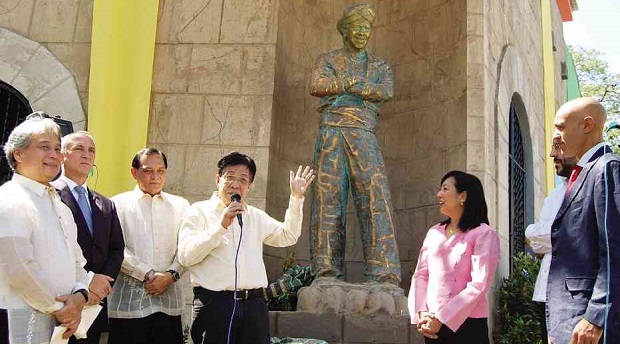
UNVEILING the statue of Manuel Conde during opening rites (from left): FDCP head Briccio Santos, Michel Stanilas Villar of the French Embassy, Rep. Celso Lobregat, Jun Urbano and Mayor Maria Isabelle Climaco-Salazar. Photo by Marinel Cruz
Power outage delayed the screening of Will Fredo’s “In Nomine Matris” during the recent Zamboanga International Film Festival, but the audience that filled the newly opened 150-seat cinematheque stayed on, reported lead actress Liza Diño.
The blackout, which affected the island of Mindanao, struck in the final 15 minutes of the movie, Diño related. She posted on her Facebook page: “Maraming salamat sa mainit na pagtanggap … Hindi n’yo kami iniwan.”
“In Nomine Matris” was among the featured films at the five-day (Feb. 26-March 2) 2014 Zamboanga IFF held at the cinematheque located on Veterans Avenue cor. Legionnaire Road. The establishment, the fifth to be financed by the Film Development Council of the Philippines (FDCP), sits on a 400-sq m lot donated by the local government.
Testament
In his welcome speech, FDCP chair Briccio Santos said, “This distinguished film festival has gained a permanent home with the establishment of the cinematheque. It [is] a testament to FDCP’s commitment to keep alive the dynamic film scene among [regional] filmmakers and viewing audiences.”
The FDCP earlier built cinematheques in Baguio, Iloilo, Davao and Marawi.
Spanish director Pablo Berger’s silent fantasy movie, “Blancanieves” was the opening film. Other foreign titles screened at the cinematheque were: “El Secreto de Sus Ojos,” “Siete Mesas de Billar Frances,” “Copito de Nieve,” “Arrugas” and “O Apostolo.” A number of Filipino films coproduced by the FDCP were shown at the nearby Mindpro Citimall.
Zamboanga 1st District Representative Celso Lobregat, after seeing a historical movie set in Baler, Aurora, challenged indie directors in Zamboanga to make films about the province.
“Here in Zamboanga, the last Spanish general surrendered to Filipino fighters,” noted Lobregat, quoting from a book by local historian and professor Clem Bascar, “Mindanao: Where the Last Castilian Lion Roared.”
“Baler,” a Mark Meily film, is based on the Siege of Baler that lasted 337 days in 1898. It was among the featured movies at the Zamboanga IFF in 2013.
“Our local filmmakers are very active. We hope the creation of the cinematheque will [further] encourage them,” Lobregat told the Philippine Daily Inquirer.
He admitted that the armed conflict in September between government forces and a faction of the Moro National Liberation Front (MNLF) had caused delays in the construction of the cinematheque. “Work was stalled until November, but we’re almost finished,” Lobregat said. “[In] three more weeks, everything will be installed.” He later brought FDCP officials and guests to ground zero, only 100 meters from the cinematheque.
Therapeutic
Mayor Maria Isabelle Climaco-Salazar stressed the importance of the cinematheque for a city still recovering from the crisis. “This establishment is very close to ground zero. Some of buildings around it were used [as rebel or military hideouts] at the height of the siege,” she recalled. “Watching movies could be therapeutic; it could help those affected to forget the pain, and release pent-up emotions.”
The mayor reported the recent FDCP-initiated film screening, through the Sine ng Masa (People’s Mobile Cinema) program, at the evacuation centers in Barangay Tetuan.
Salazar was confident that the cinematheque would soon be screening local filmmakers’ works. “Our young film students are inspired by the achievements of former students who are now internationally acclaimed. This market is ripe and thriving,” she stressed.
She cited Zamboanga-born director Sheron Dayoc, whose first full-length feature, “Halaw,” won top awards from film festivals in Germany, United States and Hong Kong.
The opening of the cinematheque coincided with the celebration of the 77th Dia de la Ciudad de Zamboanga, a week-long commemoration of Zamboanga’s proclamation as a chartered city. During the ceremony, a bronze statue of the late filmmaker Manuel Conde, sculpted by artist Jonas Roces, was unveiled. Conde’s son, actor-director Jun Urbano, was guest of honor.
“This cinematheque is rendered all the more distinguished with this statue,” said FDCP chief Santos. “We relive [Conde’s] legacy as contemporary Philippine cinema has emulated his shining example and found an enviable place on the world map.”
Urbano thanked the FDCP for honoring his father, immortalized as the lead character in the 1955 classic “Juan Tamad Goes to Congress.” He said: “I was just a little boy when I first came here with my mother. My father didn’t want to use fake props so we came here for authentic jewelry, costumes and kampilan (single-edged sword),” he recalled. “I’m truly grateful … I know my father is up there somewhere, not knowing how to thank you for this honor.”
FDCP executive director Teodoro Granados emceed the thee-hour rites, which featured performances from local traditional dancers. Also present were Michel Stanilas Villar, counselor for cooperation and cultural affairs of the embassy of France; Ignacio Perez Cambra, deputy head of mission of the embassy of Spain; Martin Macalintal, audio-visual attaché of the embassy of France; Will Fredo, “In Nomine Matris” director; Al Gatmaitan, actor; and Ayeen Pineda, “Si Pagong at Si Matsing” producer.
(Email mcruz@inquirer.com.ph)